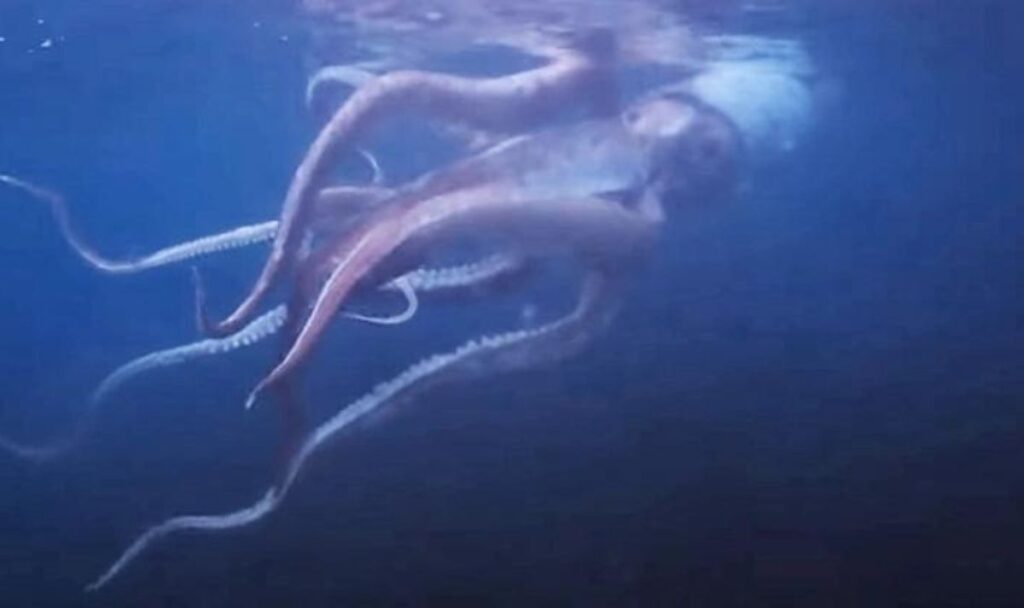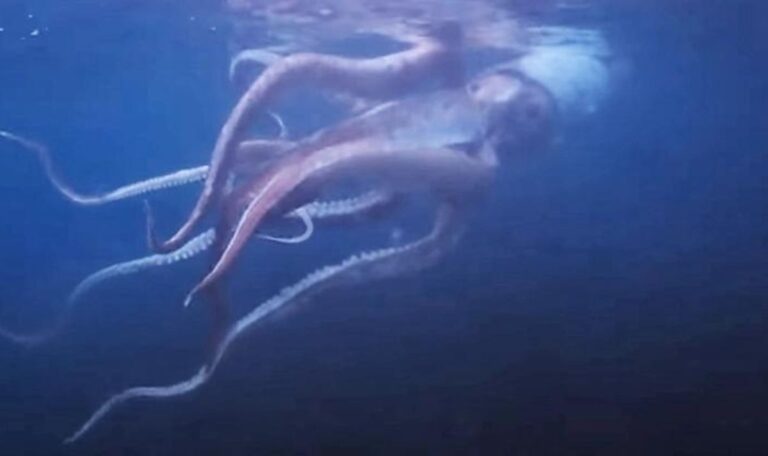The depths of the ocean have always held a profound fascination for humanity. Beneath the waves lie mysteries waiting to be unraveled, and one of the most enigmatic creatures lurking in the dark abyss is the giant squid (Architeuthis dux). With its elusive nature, massive size, and the legends it has inspired over centuries, the giant squid has become a symbol of the unknown depths of our oceans. In this article, we’ll embark on a deep-sea journey to explore the captivating world of the giant squid, delving into its biology, behavior, and the ongoing quest to uncover its secrets.
Anatomy and Appearance of The Giant Squid
The giant squid is an oceanic behemoth, known for its enormous size and distinctive appearance. Adult giant squids can reach lengths of up to 43 feet (13 meters) or even more, including their long, tentacle-like appendages. These cephalopods possess a complex body structure, which showcases their evolutionary adaptability.
Tentacles and Arms: Giant squids have eight long and powerful arms, each lined with hundreds of sharp, toothed suckers. These arms serve a dual purpose – capturing prey and bringing it closer to the squid’s beak-like mouth.
Beak and Radula: The beak of the giant squid is a formidable tool, capable of crushing and tearing apart the tough exoskeletons of their prey, which often include deep-sea fish and other cephalopods. Additionally, they possess a radula, a raspy tongue-like organ used to help process food before it reaches the digestive system.
Eyes: One of the most astonishing features of the giant squid is its enormous eyes. These eyes, often the size of basketballs, are among the largest in the animal kingdom. Their size allows giant squids to capture as much light as possible in the pitch-black depths of the ocean, aiding in the detection of prey and potential predators.
Glowing Tentacle Tips: Another intriguing characteristic of giant squids is the bioluminescence of their tentacle tips. These light-producing organs may serve multiple functions, including attracting prey or confusing predators.

Habitat and Behavior
Giant squids are thought to inhabit the world’s deep oceans, where pressures can reach over 1,000 times that of the surface and temperatures plunge to near freezing. Their preferred depth ranges from 1,000 to 2,000 meters (3,280 to 6,560 feet), making them elusive to human observation. Their behavior remains largely a mystery, but scientists have pieced together some aspects of their life cycle and habits.
Hunting Strategies: Although limited direct observations of giant squid hunting behavior exist, their anatomy suggests that they are powerful predators. They likely use their tentacles to ensnare prey, then draw it toward their beak for consumption.
Reproduction: The reproductive habits of giant squids are still not fully understood, but it is believed that they undergo a remarkable transformation as they mature. After hatching from eggs, juvenile squids are thought to inhabit shallower waters, while adults venture into the deep ocean. Mating likely occurs at great depths, with males transferring spermatophores to females using specialized tentacles.
Predators and Defense Mechanisms: Adult giant squids have few known natural predators, with sperm whales being one of their primary threats. To defend themselves, giant squids may employ ink as a smokescreen to escape from predators or release bioluminescent fluid to distract or confuse threats.
The Elusive Nature of the Giant Squid
For centuries, giant squids remained an enigmatic legend, with accounts of encounters often relegated to maritime folklore. Ancient sailors told stories of terrifying battles with sea monsters, their tentacles emerging from the depths to wreak havoc on ships. However, it wasn’t until relatively recently that scientists began to unravel the mysteries of these deep-sea giants.
Historical Accounts: Historical records of giant squid encounters date back to the early 17th century. Tales of colossal tentacles rising from the depths fueled myths and legends about the creatures. One of the most famous early accounts is the Danish naturalist Japetus Steenstrup’s discovery of a giant squid beak in 1857, which provided crucial evidence of the creature’s existence.
Early Scientific Discoveries: The 19th and 20th centuries brought significant progress in the study of giant squids. Researchers began collecting specimens and gathering more detailed information about their anatomy and habits. However, live observations remained exceptionally rare.
First Live Giant Squid Encounters: In recent years, technological advancements in deep-sea exploration have allowed scientists to capture the first live images and footage of giant squids in their natural habitat. In 2004, a team of Japanese scientists succeeded in capturing the first images of a giant squid using a remote-operated vehicle. Subsequent expeditions have provided more insights into their behavior and habitat.
Ongoing Scientific Efforts
While we have made significant strides in understanding giant squids, many questions remain unanswered. Scientists are dedicated to furthering our knowledge of these mysterious creatures.
Genetic Analysis: Advances in genetic analysis have enabled researchers to examine the DNA of preserved giant squid specimens. This has provided insights into their evolutionary history and relationships with other cephalopods.
Deep-Sea Exploration: The development of submersibles, remotely operated vehicles (ROVs), and autonomous underwater vehicles (AUVs) has expanded our ability to explore the deep ocean. These technologies are instrumental in capturing more information about giant squids and their habitats.
Conservation Concerns
The giant squid, like many deep-sea species, faces potential threats from human activities, including deep-sea fishing and mining operations. As we learn more about these creatures, it is essential to consider their conservation.
Protection of Habitats: Preserving the deep-sea habitats that giant squids call home is crucial to their survival. Establishing marine protected areas and regulating deep-sea fishing practices can help protect these environments.
Mitigating Bycatch: Bycatch in deep-sea fisheries can pose a significant threat to giant squids. Developing and implementing bycatch mitigation measures can reduce the unintentional capture of these creatures.
Conclusion
The giant squid, a symbol of the mysteries of the deep, has fascinated humans for centuries. With its enormous size, complex anatomy, and elusive behavior, it continues to be a subject of scientific exploration and wonder. Advances in technology have allowed us to catch glimpses of these enigmatic creatures in their natural habitat, yet much remains to be discovered about their biology and behavior. As we continue to probe the depths of the ocean, the giant squid remains a testament to the wonders that await us beneath the waves, reminding us of the boundless mysteries of the world’s oceans and the importance of their conservation.
UP NEXT
The Leafy Sea Dragon: Among the Strangest Ocean Creatures
Manta Tornado -Exploring the Mysteries of Manta Ray behaviour



